

Home : Cell Migration Gateway. Polarization Cell polarization refers to the tendency of migrating cells to have a distinct, stable front and rear.

The polarity is reinforced and often even arises from environments that provide a directional cue. These directional cues can be chemotactic, (induced by chemoattractants or morphogens), haptotactic (caused by varying concentrations of substrate), mechanotactic (breakdown of cell-cell contacts, as in wound healing), electrotactic (induced by electric fields), and 'durotactic', (due to differences in pliability), or combinations of any of these. The result is a defined cell front and a rear. The leading edge is usually characterized by intense actin polymerization that generates a protrusive structure, and by adhesion to the substratum. Some cells polarize by forming a front in response to an external agent. Protrusion Protrusion is the de novo formation of membrane extensions, or protrusions, in the direction of migration, i.e. the leading edge.
Adhesion. Vietnamese Boat People. The ‘Boat People of Vietnam’ seemed to encapsulate all the suffering Vietnam had suffered from 1965 to 1975.
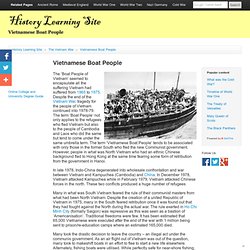
Despite the end of the Vietnam War, tragedy for the people of Vietnam continued into 1978-79. The term ‘Boat People’ not only applies to the refugees who fled Vietnam but also to the people of Cambodia and Laos who did the same but tend to come under the same umbrella term. The term ‘Vietnamese Boat People’ tends to be associated with only those in the former South who fled the new Communist government.
However, people in what was North Vietnam who had an ethnic Chinese background fled to Hong Kong at the same time fearing some form of retribution from the government in Hanoi. In late 1978, Indo-China degenerated into wholesale confrontation and war between Vietnam and Kampuchea (Cambodia) and China. Many in what was South Vietnam feared the rule of their communist masters from what had been North Vietnam. Puerto Ricans in the United States. A Puerto Rican American (Spanish: puertorriqueño-americano[2][3]) or Stateside Puerto Rican[4][5] (estadounidense de origen puertorriqueño[6][7]), is an American born in either Puerto Rico or the United States that is of full or partial Puerto Rican origin and has lived a significant part of their lives in one of the states of the United States or the District of Columbia.[8] At nine percent of the Latino population in the United States, Puerto Ricans are the second largest Hispanic group nationwide, and comprise 1.5% of the entire population of the United States.[9] Although the 2010 Census counted the number of Puerto Ricans living in the United States at 4.6 million, more recent estimates show the Puerto Rican population to be over 5 million, as of 2012.[10][11] Identity[edit] Puerto Ricans have been migrating to the United States since the 19th century and have a long history of collective social advocacy for their political and social rights and preserving their cultural heritage.
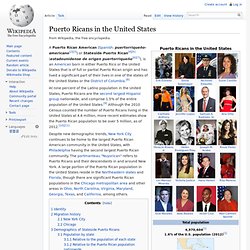
Bird migration. Examples of long distance bird migration routes.

Bird migration is the regular seasonal movement, often north and south along a flyway between breeding and wintering grounds, undertaken by many species of birds. Migration, which carries high costs in predation and mortality, including from hunting by humans, is driven primarily by availability of food. Migration occurs mainly in the Northern Hemisphere where birds are funnelled on to specific routes by natural barriers such as the Mediterranean Sea or the Caribbean Sea. Historically, migration has been recorded as much as 3,000 years ago by Ancient Greek authors including Homer and Aristotle, and in the Book of Job, for species such as storks, Turtle Doves, and swallows. Refugees and Migrants. Sahara desert deaths: 92 perish in Niger after vehicle breakdowns. Volunteers dig graves for a group of migrants who died of thirst after their truck broke down in the Sahara Desert north of Arlit, Niger, on Wednesday, October 30.
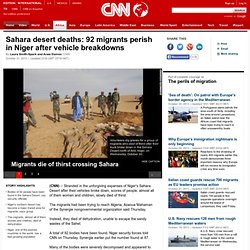
Men cover the bodies of the migrants. Ninety-two bodies have been found, Niger security forces said Thursday. Africa for Kids - African Slave Trade. Over a period of about 400 years, about 10-15 million African people were kidnapped and sold into slavery.
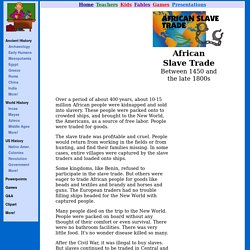
These people were packed onto to crowded ships, and brought to the New World, the Americans, as a source of free labor. People were traded for goods. The slave trade was profitable and cruel. People would return from working in the fields or from hunting, and find their families missing. In some cases, entire villages were captured by the slave traders and loaded onto ships. Convicts in Australia. During the late 18th and 19th centuries, large numbers of convicts were transported to the various Australian penal colonies by the British government.
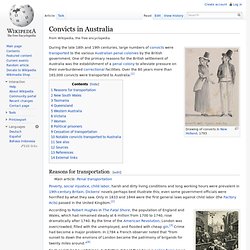
One of the primary reasons for the British settlement of Australia was the establishment of a penal colony to alleviate pressure on their overburdened correctional facilities. Over the 80 years more than 165,000 convicts were transported to Australia.[1] Reasons for transportation[edit] Poverty, social injustice, child labor, harsh and dirty living conditions and long working hours were prevalent in 19th-century Britain. Dickens' novels perhaps best illustrate this; even some government officials were horrified by what they saw. Each parish had a watchman, but Britain did not then have a police force as we know it.
Due to the Bloody Code, by the 1770s, there were 222 crimes in Britain which carried the death penalty,[5] almost all of them for crimes against property. New South Wales[edit] Tasmania[edit] Port Arthur Prison settlement site.